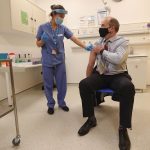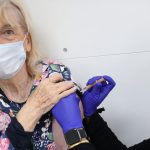Sewage monitoring has shown there was a “widespread increase” in the concentration of COVID-19 in England throughout June.
Samples of wastewater taken from around 270 sewage treatment works were tested for fragments of coronavirus.
Live COVID updates from UK and around the world
People shed fragments of the virus through daily activities such as going to the loo or blowing their nose, which then enter the sewer system through sinks, drains and toilets.
The increase in the concentration of COVID in wastewater was “indicative of increasing prevalence”, according to a report by the Environmental Monitoring for Health Protection (EMHP) wastewater surveillance programme.
The increase was not consistent across all monitoring sites, with some areas showing an overall decrease.
“Generally, the more people with COVID-19 in the community the more viral RNA (ribonucleic acid) will be shed into wastewater,” the report says. “Therefore, the concentration in wastewater is indicative of the prevalence of COVID-19 in the community.”
The programme helps identify where the virus is circulating in England and can detect spikes in prevalence and the presence of variants.
It can also detect the virus even if people don’t have symptoms and haven’t been tested.
Genomic sequencing of wastewater samples can “provide an indication of where VOCs (variants of concern) and VUIs (variants under investigation) may be present across England”, the report said.
It added: “This is done through genomic sequencing of wastewater samples, to provide an indication of where VOCs and VUIs may be present across England.
“Insights from wastewater monitoring are shared with local and national decision makers, to help inform the action that they can take to stop further transmission.”
Taken with other testing programmes, the programme says it can “help protect against the threat of new variants”.
“Wastewater monitoring complements other testing programmes and public health actions to help protect against the threat of new variants, as the country closely follows the roadmap out of national restrictions,” the report says.
Please use Chrome browser for a more accessible video player
It comes as the UK recorded 27,734 new coronavirus cases and 91 more deaths on Wednesday, the first rise in cases after seven consecutive days of falling numbers.
Despite the rise in cases, the seven-day average was 36.1% down from the previous week.
Meanwhile, the latest Office for National Statistics survey has suggested people who catch coronavirus a second time have a lower viral load than the first time, indicating they will have milder symptoms.
The survey also suggested one in four young adults who test positive for COVID are no longer following the rules for self-isolating.






















